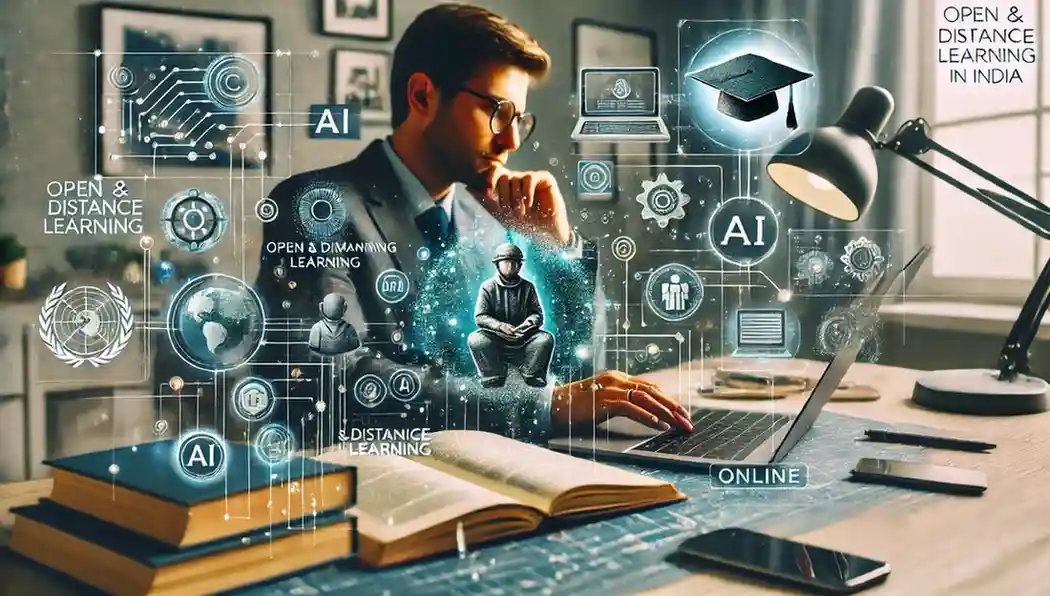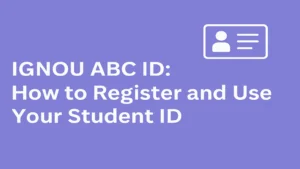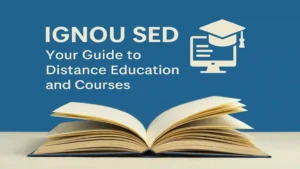Introduction: Understanding Open and Distance Learning (ODL) in India
What is Open and Distance Learning?
Open and Distance Learning (ODL) refers to educational systems that allow students to learn from a distance without the need for physical attendance at a traditional educational institution. In ODL, learning is facilitated through various communication mediums such as online platforms, printed materials, radio, television, and more. This flexibility in delivery makes it an ideal mode of education for students who cannot participate in traditional in-person learning.
Evolution of ODL in India: A Brief History
ODL has seen significant evolution in India, starting with the establishment of the Indira Gandhi National Open University (IGNOU) in 1985. Initially, it was limited to a few courses and certifications, but today, it spans undergraduate, postgraduate, diploma, and certificate programs in a variety of fields. The growth of the internet and digital platforms over the past two decades has contributed immensely to the widespread acceptance and development of ODL.
Importance of ODL in the Modern Educational Landscape
ODL plays a crucial role in India’s education system by providing flexible learning opportunities for individuals who face geographical, financial, or time constraints. It has bridged the gap for students from rural areas and working professionals who seek to continue their education while managing other responsibilities.
The Role of ODL in Democratizing Education in India
Open and Distance Learning has democratized education by providing equal opportunities to learners across India, irrespective of their socio-economic background. It has proven to be a valuable tool for marginalized groups, women, and rural students, offering them access to quality education without the constraints of traditional classroom settings.
The Growing Popularity of Open and Distance Learning
Key Statistics and Trends in ODL Enrollment
ODL enrollment in India has seen a steady rise. In fact, according to a 2022 report from the Ministry of Education, over 30 million students are currently enrolled in various ODL programs across the country. The number of ODL institutions, including private universities and online platforms, continues to increase, reflecting a growing acceptance of this model of education.
Factors Contributing to the Rise of ODL in India
Several factors have contributed to the growing popularity of ODL in India:
- Technological Advancements: The widespread availability of the internet and smartphones has made online education more accessible than ever.
- Flexible Learning: ODL allows students to study at their own pace and on their schedule, making it easier to balance education with work and personal commitments.
- Affordability: Compared to traditional education, ODL programs are often more affordable, allowing students from various socio-economic backgrounds to access higher education.
COVID-19 and the Accelerated Shift Toward Distance Learning
The COVID-19 pandemic forced educational institutions to move online, which accelerated the adoption of distance learning. ODL platforms were pivotal during this period, offering uninterrupted learning when traditional institutions were closed due to lockdowns. This shift also proved that education could be effective and sustainable in a digital format.
Role of Government Initiatives and Policies in Promoting ODL
The Government of India has recognized the potential of ODL in widening access to education. Policies such as the National Policy on Education (NPE) and schemes like the SWAYAM platform and National Repository of Open Educational Resources (NROER) have been launched to support and promote ODL in India.
Technological Advancements Shaping the Future of ODL
The Role of Internet Connectivity in Expanding ODL Reach
Improved internet connectivity, especially in rural India, has been a game-changer for ODL. The Indian government’s Digital India initiative aims to expand internet access, providing a broader audience with the ability to enroll in online courses and earn degrees and certifications from the comfort of their homes.
Advancements in Online Platforms for ODL Delivery
The growth of user-friendly, interactive online platforms has made it easier for students to engage with course materials, participate in discussions, and collaborate with peers. Platforms like Google Classroom, Moodle, and Zoom have become an integral part of ODL programs, enhancing the learning experience and increasing student engagement.
Artificial Intelligence (AI) and Its Potential in Personalized Learning
AI has the potential to revolutionize ODL by offering personalized learning experiences. AI-driven tools can track a student’s progress, analyze their learning behavior, and suggest customized content to help them improve their understanding. This level of personalization ensures that students receive targeted support, which can significantly enhance their learning outcomes.
The Integration of Virtual Reality (VR) and Augmented Reality (AR) in Distance Learning
Virtual and Augmented Reality are exciting innovations that can take distance learning to the next level. For example, medical students can use VR simulations to practice surgeries, and architecture students can walk through virtual 3D models of buildings. These immersive experiences can bridge the gap between theory and practical knowledge, offering students hands-on learning experiences.
Mobile Learning and its Role in Shaping the ODL Landscape
With the growing use of smartphones, mobile learning has become an essential aspect of ODL. Mobile apps offer on-the-go access to study materials, video lectures, and quizzes, making it easier for students to learn anywhere, anytime. This flexibility is particularly beneficial for working professionals who may not have the time to sit at a computer.
ODL vs. Traditional Education: A Comparative Analysis
Flexibility vs. Structured Learning: Which is More Beneficial?
While traditional education offers a structured curriculum and face-to-face interaction with instructors, ODL provides the flexibility to learn at your own pace. This flexibility is particularly valuable for non-traditional students, such as working professionals, stay-at-home parents, and people from remote areas.
Cost-Effectiveness of ODL as Compared to Conventional Education
ODL programs are typically more affordable than traditional degrees, as they eliminate the need for campus infrastructure and other associated costs. Students can save money on commuting, accommodation, and materials, making education more accessible.
Learning Outcomes: How Does ODL Measure Up?
Research has shown that the learning outcomes of ODL can be as effective as traditional education if the programs are designed well. ODL offers an opportunity for independent learning and critical thinking, which are essential skills for the modern workforce.
Student Engagement and Interaction in ODL
While ODL lacks the face-to-face interaction that traditional classrooms offer, it provides various online tools such as forums, webinars, and group discussions to foster student engagement. The challenge is ensuring that students remain motivated and actively participate in the learning process.
Government Policies and Support for Open and Distance Learning
The National Policy on Education and Its Impact on ODL
The National Policy on Education (NPE), which aims to make education more inclusive and accessible, has paved the way for the growth of ODL. The policy supports the development of digital education platforms and encourages the use of technology in education.
The Role of University Grants Commission (UGC) in Regulating ODL
The University Grants Commission (UGC) plays a key role in regulating and accrediting ODL programs in India. It ensures that the programs offered by open universities meet the required academic standards, thereby maintaining the credibility of distance education.
Key Government Schemes Supporting ODL Growth
Initiatives like SWAYAM (Study Webs of Active-Learning for Young Aspiring Minds) and NPTEL (National Programme on Technology Enhanced Learning) are government-supported platforms that offer free online courses from top Indian institutions. These programs have made quality education accessible to students across India.
How Public and Private Institutions Are Collaborating to Promote ODL
Public and private institutions are increasingly collaborating to offer joint ODL programs, providing a wider range of courses and degrees to students. This collaboration brings together the strengths of both sectors—academic rigor from public institutions and innovative delivery methods from private institutions.
Quality Assurance in Open and Distance Learning
Accreditation and Affiliation: Ensuring Quality Standards in ODL
Accreditation is crucial to ensuring the quality of ODL programs. Institutions must meet specific standards set by bodies such as the UGC and the National Board of Accreditation (NBA). Accreditation provides students with assurance that the programs they are pursuing are recognized and of high quality.
Best Practices in Course Design and Delivery
For ODL programs to be effective, they must be designed with the learner’s needs in mind. Best practices include creating interactive, engaging content, offering clear learning outcomes, and providing timely feedback. Regular updates and revisions of course materials ensure that the content stays relevant.
Faculty Development Programs for Distance Education Instructors
Faculty development is essential to ensure that instructors are equipped to teach in an online environment. Training programs that focus on the use of digital tools, online assessments, and student engagement strategies are key to maintaining the quality of ODL instruction.
Ensuring Student Support Services in ODL
ODL programs should provide comprehensive student support, including access to academic advisors, tutors, and technical assistance. Additionally, mental health support and peer interaction opportunities are essential for maintaining students’ well-being and motivation.
Challenges Facing the Open and Distance Learning System in India
Infrastructure Barriers: Limited Internet Access in Rural Areas
While urban areas enjoy high-speed internet, rural regions still face connectivity issues, which can hinder the effectiveness of ODL. Efforts to improve internet infrastructure are crucial for ensuring that ODL is accessible to all students.
Quality Control Issues in ODL Programs
Ensuring the quality of education in ODL programs is challenging, especially with the proliferation of online learning platforms. Many programs lack proper oversight, leading to concerns over their academic rigor and credibility.
Student Motivation and Self-Discipline in Distance Learning
ODL requires a higher level of self-motivation and discipline from students, as they do not have the structure of a traditional classroom. Without regular interactions with peers and instructors, students may struggle to stay focused and complete their assignments on time.
The Digital Divide: Inequality in Access to Technology
The digital divide remains a significant issue in India, where many students do not have access to the necessary technology—such as laptops, smartphones, or reliable internet connections—needed to participate in ODL.
Handling Assessment and Evaluation in ODL
Traditional assessment methods, such as in-person exams, are not feasible in ODL settings. Online assessment methods need to be secure, reliable, and capable of accurately evaluating students’ knowledge and skills.
The Role of ODL in Providing Lifelong Learning Opportunities
Upskilling and Reskilling through ODL
ODL provides an excellent platform for professionals looking to upskill or reskill. Online certification programs in areas such as data science, digital marketing, and business management allow individuals to advance their careers while working.
ODL for Career Development: Opportunities for Professionals
Many ODL programs are designed to meet the needs of working professionals. These programs offer flexible schedules and industry-relevant content, making them an attractive option for career advancement.
How ODL is Bridging the Skill Gap in India’s Workforce
ODL programs are helping bridge the skills gap in India’s workforce by offering specialized courses in emerging fields such as artificial intelligence, blockchain, and cybersecurity.
Incorporating Soft Skills into ODL Curriculum
In addition to technical skills, ODL programs are increasingly focusing on the development of soft skills, such as communication, teamwork, and leadership, which are essential for professional success.
Future Trends in Open and Distance Learning
The Rise of Microlearning and Bite-Sized Education
Microlearning, which involves learning in small, focused segments, is gaining popularity in ODL. This format is ideal for busy professionals who want to learn in short bursts, and it allows for more targeted learning.
The Role of Blockchain Technology in ODL Credentialing
Blockchain technology can revolutionize credentialing in ODL by providing secure, transparent records of student achievements. This can help prevent credential fraud and make it easier for employers to verify qualifications.
Gamification and Interactive Learning: The Next Frontier in ODL
Gamification is becoming a powerful tool in ODL to increase student engagement. Interactive simulations, quizzes, and badges motivate learners by adding an element of fun and competition to the educational process.
The Shift Toward Competency-Based Learning Models
Competency-based learning, where students progress upon mastering specific skills, is gaining traction in ODL. This model allows for personalized learning experiences and ensures that students acquire the necessary competencies before moving on to advanced topics.
The Growth of Global Partnerships and International ODL Programs
ODL is expanding beyond national borders. International partnerships between universities and online platforms are creating opportunities for students in India to earn globally recognized degrees and certifications.
The Role of Open Universities and ODL Providers in India
IGNOU: Leading the ODL Revolution in India
IGNOU remains the leader in ODL in India, offering a wide range of programs and enrolling millions of students annually. The university continues to innovate and improve its offerings to meet the changing needs of the digital learner.
Other Prominent Open Universities and Their Contributions
Other open universities, such as Dr. B.R. Ambedkar Open University and the University of Delhi’s School of Open Learning, are also contributing to the ODL ecosystem. These institutions offer various undergraduate and postgraduate programs to cater to a wide range of academic interests.
Private Sector Players in the ODL Space
The private sector is increasingly entering the ODL space, offering specialized courses and certifications in fields like technology, business, and health. Private institutions often leverage cutting-edge technology and industry collaborations to offer high-quality, market-relevant education.
The Importance of Industry Partnerships in ODL Programs
Collaborations between educational institutions and industry partners help make ODL programs more relevant to the job market. These partnerships ensure that courses are aligned with current industry needs, improving employability for graduates.
The Social Impact of Open and Distance Learning in India
Providing Educational Opportunities to Marginalized Communities
ODL has proven to be a powerful tool in providing education to marginalized groups such as rural communities, women, and economically disadvantaged students. By removing geographical barriers, ODL offers these groups the opportunity to pursue higher education and improve their socio-economic conditions.
The Empowerment of Women through ODL
ODL has empowered women by providing them with the flexibility to study at their own pace while balancing family responsibilities. Many women, especially in rural areas, have benefited from distance education, leading to increased social and economic participation.
ODL as a Tool for Rural Development
In rural areas, where traditional educational infrastructure is limited, ODL has emerged as a tool for social and economic development. It helps in enhancing the skill sets of the rural population, enabling them to participate more actively in the economy.
Addressing Regional Educational Disparities through ODL
ODL helps reduce regional disparities in education by providing high-quality educational opportunities to students in remote and underserved areas. This is vital for promoting inclusive education and ensuring that no one is left behind.
How ODL is Supporting Inclusive Education in India
Special Education Needs and ODL Solutions
ODL is making strides in supporting learners with special education needs. Online platforms can offer customized content, including audio, visual aids, and interactive modules, to meet the diverse needs of learners with disabilities.
ODL for Differently-Abled Learners
For differently-abled learners, ODL offers flexibility in learning while accommodating their unique requirements. By removing the need to travel to physical campuses, ODL ensures that education is accessible to all students.
How ODL is Breaking Down Barriers for Non-Traditional Students
ODL is ideal for non-traditional students, including adult learners, working professionals, and first-generation learners, who may have been excluded from the traditional education system due to various constraints. ODL provides them with opportunities to pursue their academic and career goals.
The Role of ODL in Serving First-Generation Learners
For first-generation learners, ODL can be a game-changer. It offers these students a chance to break the cycle of poverty and gain the skills and knowledge needed to improve their social and economic standing.
Overcoming the Challenges: Recommendations for a Better ODL Future
Expanding Digital Infrastructure Across Rural Areas
To ensure that ODL reaches every corner of India, expanding internet access in rural areas is essential. This includes improving broadband connectivity and providing affordable smartphones and data packages to students.
Strengthening Regulatory Frameworks for ODL Programs
A stronger regulatory framework is needed to ensure that ODL programs meet quality standards and provide value to students. This can be achieved through clearer accreditation processes and more rigorous oversight by educational authorities.
Encouraging Collaboration Between Educational Institutions and Tech Companies
Collaboration between educational institutions and technology companies can help create better ODL platforms and improve the learning experience. These partnerships can bring innovation and enhance the accessibility of quality education.
Fostering a Student-Centered Approach in ODL Design and Delivery
A student-centered approach should be at the core of ODL programs. This means designing courses that are engaging, interactive, and tailored to the needs and learning styles of students.
Case Studies of Successful Open and Distance Learning Initiatives in India
IGNOU’s Successful Programs and Initiatives
IGNOU’s diverse range of programs, such as its MBA and MA in Education, have been widely successful, serving as a model for other institutions in the country. IGNOU’s emphasis on accessibility and flexibility has helped it become the largest open university in the world.
State-Level Initiatives: Leveraging ODL for Local Development
Many state governments have launched initiatives to promote ODL, such as the Maharashtra State Open University, which offers regional courses focused on local development. These initiatives help address the unique educational needs of the state’s population.
Collaboration Between Public and Private Sectors in ODL
Collaborations between public universities and private ed-tech platforms have made ODL more accessible. These collaborations combine the credibility of public institutions with the innovative approaches of private companies.
International Collaborations in ODL: Examples from India
India is also seeing increasing international collaboration in ODL. Partnerships with foreign universities allow Indian students to access world-class education from home, making ODL a truly global phenomenon.
FAQs
What is Open and Distance Learning (ODL) in India?
Open and Distance Learning (ODL) refers to an educational system where students can study without needing to attend physical classes. It is often delivered through online platforms, radio, TV, printed materials, or other digital mediums. ODL allows students to learn at their own pace and from any location, making education more accessible to people across India, particularly in rural or remote areas.
How can I enroll in an ODL program in India?
Enrollment in an ODL program typically involves choosing a course or program offered by accredited institutions such as IGNOU or other state universities. To enroll, you must visit the official website of the institution offering the program, fill out the application form, and submit required documents. Many programs also offer online application processes, making it easier to apply from anywhere.
Are ODL degrees recognized by employers?
Yes, ODL degrees from recognized institutions such as IGNOU, Dr. B.R. Ambedkar Open University, and other accredited universities are widely accepted by employers. These institutions follow the same curriculum standards as traditional universities, ensuring that their degrees have academic credibility and industry recognition. Always check if the institution is UGC-approved before enrolling.
What are the main challenges of studying through ODL in India?
While ODL offers flexibility, it comes with its own set of challenges. These include:
Limited internet access in rural areas, making it hard for some students to access online learning materials.
Motivation and discipline: ODL students need to be self-driven, as they do not have the structure of a traditional classroom.
Lack of face-to-face interaction: Some students find it difficult to engage fully with the course material and peers without in-person interaction.
Digital divide: Students without proper digital devices may face difficulty in accessing the course content.
Can I pursue multiple ODL programs simultaneously?
Yes, you can pursue multiple ODL programs simultaneously, but it depends on the institution’s rules and the difficulty level of the programs. However, managing multiple courses requires careful planning, as balancing them alongside personal or professional commitments can be challenging. Be sure to review the workload and commitment required for each program before enrolling in more than one.
Related Posts:
- IGNOU Junior Assistant Salary 2025: Payment, Benefits, Career Growth With Best Guide
- IGNOU Grade Card Calculator: A Comprehensive Guide 2025
- IGNOU Sociology Notes 2025: A Best Guide to Download & Use
- IGNOU Handwritten Assignments 2025: Download, How to use, Best Guide
- 38th IGNOU Convocation 2025: Registration, Fee Payment, Criteria, Best Guide




